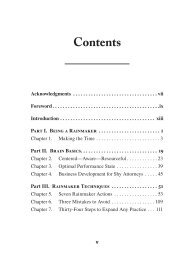(Bk Business) Carol Kinsey Goman Ph.D.-The Nonverbal Advantage_ Secrets and Science of Body Language at Work -Berrett-Koehler Publishers (2008)
Just
Just
Create successful ePaper yourself
Turn your PDF publications into a flip-book with our unique Google optimized e-Paper software.
44 <strong>The</strong> <strong>Nonverbal</strong> <strong>Advantage</strong><br />
talking. <strong>The</strong>re is <strong>of</strong>ten mutual eye<br />
contact during <strong>at</strong>tempted interruptions,<br />
laughing, <strong>and</strong> when answering<br />
short questions.<br />
In more-intense or more-intim<strong>at</strong>e<br />
convers<strong>at</strong>ions, people n<strong>at</strong>urally<br />
look <strong>at</strong> one another more<br />
<strong>of</strong>ten <strong>and</strong> hold th<strong>at</strong> gaze for longer<br />
periods. A sure sign th<strong>at</strong> a convers<strong>at</strong>ion<br />
is lagging is when one <strong>of</strong> the<br />
participants begins looking away<br />
to pay more <strong>at</strong>tention to other people<br />
or objects in the vicinity. And<br />
She has stopped listening.<br />
when she glances <strong>at</strong> her w<strong>at</strong>ch,<br />
gazes blankly into the distance, or visually scans the room,<br />
she is giving definite signals with her eyes th<strong>at</strong> she has, in<br />
effect, stopped listening.<br />
Eye Contact Avoidance<br />
In most cases too little eye contact is interpreted as being<br />
impolite, insincere, or even dishonest. One hospital, analyzing<br />
letters from p<strong>at</strong>ients, reported th<strong>at</strong> 90 percent <strong>of</strong> the complaints<br />
had to do with doctors’ poor eye contact, which was<br />
perceived as a lack <strong>of</strong> caring.<br />
Liars tend to avoid eye contact unless they are very brazen<br />
or well rehearsed—in which case liars may actually overcompens<strong>at</strong>e<br />
(to “prove” th<strong>at</strong> they are not lying) by making too<br />
much eye contact <strong>and</strong> holding it too long. With this exception<br />
the tendency is for people to avoid direct eye contact<br />
when lying <strong>and</strong>, conversely, look with full focus when telling<br />
the truth or feeling <strong>of</strong>fended by a false accus<strong>at</strong>ion. When<br />
people are dishonest or holding back inform<strong>at</strong>ion, they typically<br />
meet our gaze less than one-third <strong>of</strong> the time.




